NCERT Solutions for Class 11 Biology Chapter 14 Respiration in Plants
These Solutions are part of NCERT Solutions for Class 11 Biology. Here we have given NCERT Solutions for Class 11 Biology Chapter 14 Respiration in Plants.
Question 1.
Differentiate between
(a) Respiration and Combustion
(b) Glycolysis and Krebs’ cycle
(c) Aerobic respiration and Fermentation
Solution:
(a) Differences between respiration and combustion are as follows :

(b) Differences between glycolysis and krebs’ cycle are as follows :
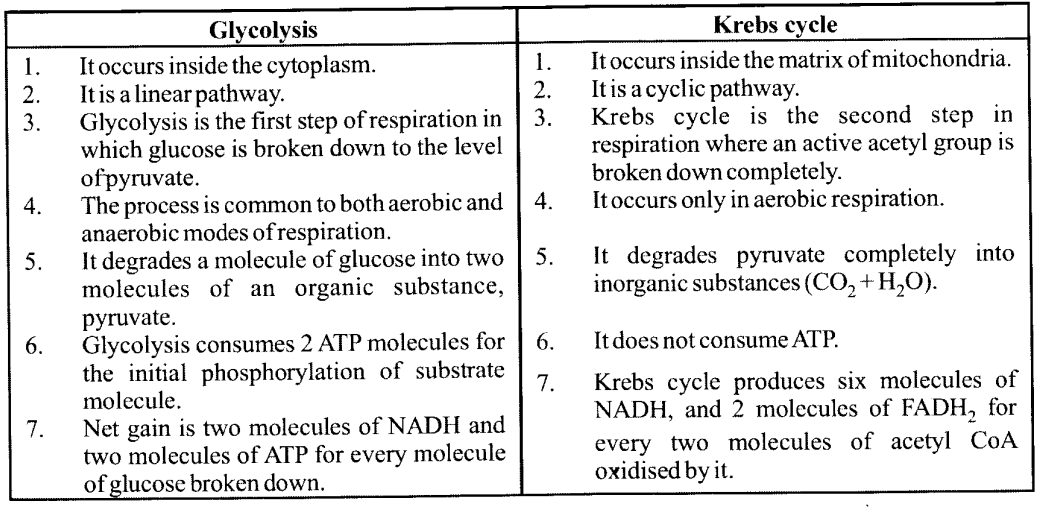
(c) Differences between aerobic respiration and fermentation are as follows :
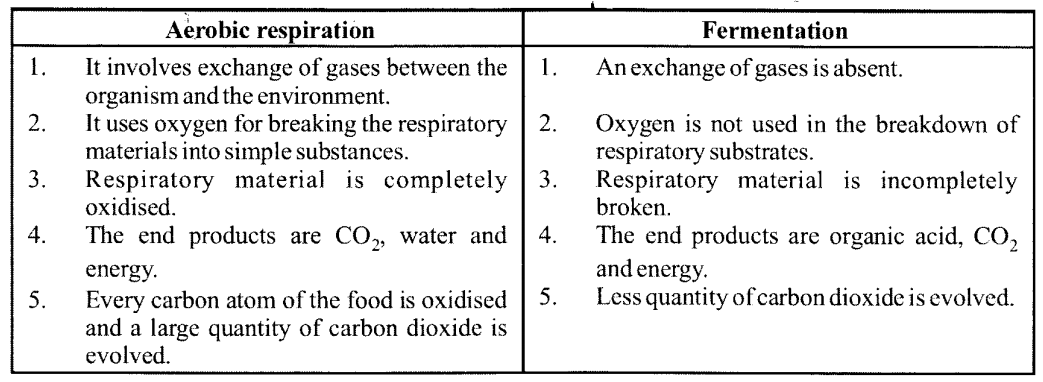
Question 2.
What are respiratory substrates? Name the most common respiratory substrate.
Solution:
The compounds that are oxidized during this process are known as respiratory substrates. Usually, carbohydrates are oxidized to release energy, but proteins, fats, and even organic acids can be used as respiratory substances in some plants, under certain conditions.
Question 3.
Give the schematic representation of glycolysis.
Solution:
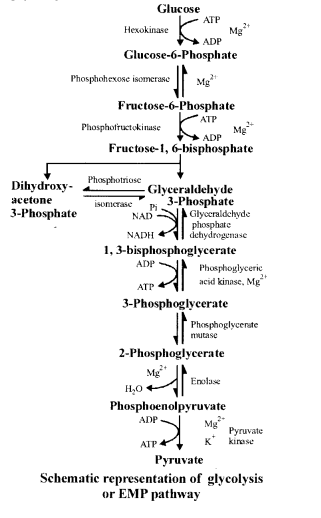
Question 4.
What are the main steps in aerobic respiration? Where does it take place?
Solution:
In aerobic respiration which takes place within the mitochondria, the final product of glycolysis, pyruvate is transported from the cytoplasm into the mitochondria.
The crucial events in aerobic respiration are:
• The complete oxidation of pyruvate by the stepwise removal of all the hydrogen atoms, leaving three molecules of CO2.
• The passing on of the electrons removed as part of the hydrogen atoms to molecular O2 with the simultaneous synthesis of ATP.
• The first process takes place in the matrix of the mitochondria while the second process is located on the inner membrane of the mitochondria.
• Pyruvate, which is formed by the glycolytic catabolism of carbohydrates in the cytosol, after it enters mitochondrial matrix undergoes oxidative decarboxylation by a complex set of reactions catalysed by pyruvic dehydrogenase. The reactions catalysed by pyruvic dehydrogenase require the participation of several coenzymes, including NAD+ and Coenzyme A.

During this process, two molecules of NADH are produced from the metabolism of two molecules of pyruvic acid (produced from one glucose molecule during glycolysis).
The acetyl CoA then enters a cyclic pathway, the tricarboxylic acid cycle, more commonly called as Krebs’ cycle.
Question 5.
Give the schematic representation of an overall view of Krebs’ cycle.
Solution:
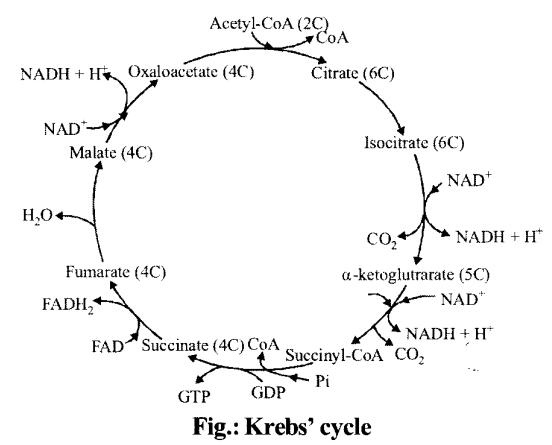
Question 6.
Explain ETS.
Solution:
ETS or electron transport system is located in the inner mitochondrial membrane. It helps in releasing and utilizing the energy stored in NADH + H+ and FADH2 NADH+ H+, which is formed during glycolyis and citric acid cycle, gets oxidized by NADH dehydrogenase. The electrons so generated get transferred to ubiquinone through FMN. In a similar manner, FADH2 generated during citric acid cycle gets transferred to ubiquinone. The electrons from ubiquinone are received by cytochrome bc1, and further get transferred to cytochrome C. The cytochrome C acts as a mobile carrier between complex III and cytochrome C oxidase complex containing cytochrome a and a3, along with copper centres.
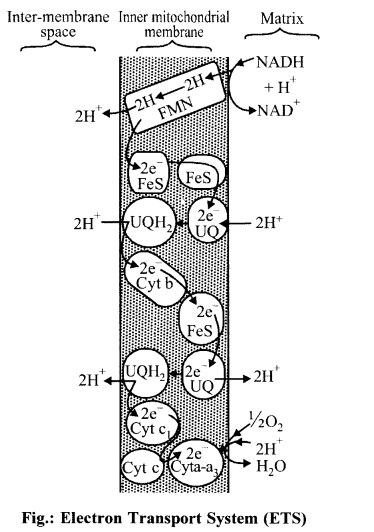
During the transfer of electrons from each complex, the process is accompanied by the production of ATP from ADP and inorganic phosphate by the action ATP synthase. The amount of ATP produced depends on the molecule, which has been oxidized.
Question 7.
Distinguish between the following:
(a) Aerobic respiration and anaerobic respiration.
(b) Glycolysis and fermentation.
(c) Glycolysis and citric acid cycle.
Solution:
Differences between aerobic respiration and anaerobic respiration are as follows :

Differences between glycolysis and fermentation are as follows :
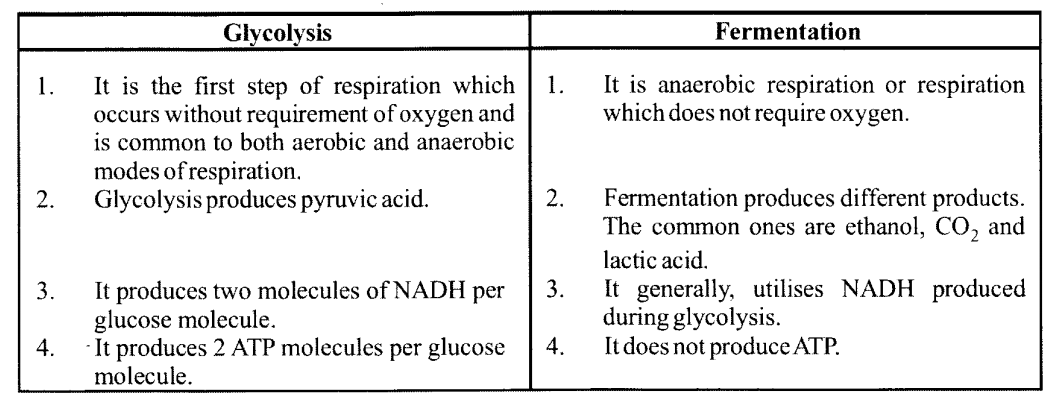
Differences between glycolysis and citric acid cycle are as follows :
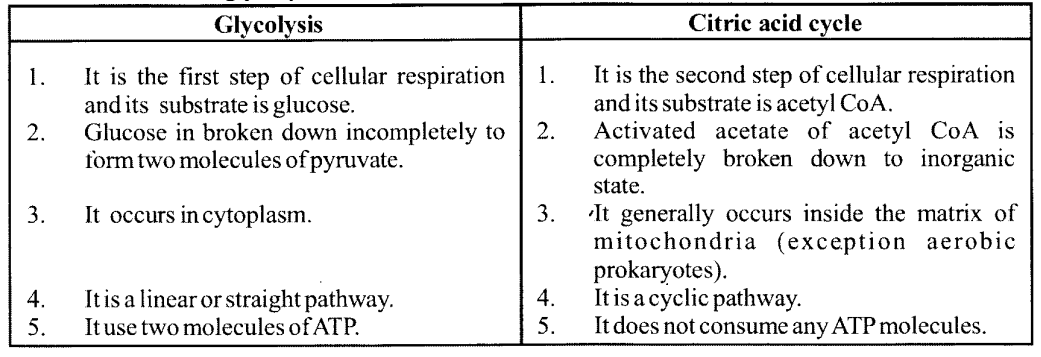
Question 8.
What are the assumptions made during the calculation of the net gain of ATP?
Solution:
- There is a sequential, orderly pathway functioning, with one substrate forming the next and with glycolysis, TCA cycle, and ETS pathway following one after another.
- The NADH synthesized in glycolysis is transferred into the mitochondria and undergoes oxidative phosphorylation.
- None of the intermediates in the pathway are utilized to synthesize any other compound.
- Only glucose is being respired -no other alternative substrates are entering the pathway at any of the intermediary stages.
Question 9.
Discuss “The respiratory pathway is an amphibolic pathway”.
Solution:
Respiration is generally assumed to be a catabolic process because, during respiration, various substrates are broken down for deriving energy. Carbohydrates are broken down into glucose before entering respiratory pathways. Fats get converted into fatty acids and glycerol whereas fatty acids get converted into acetyl CoA before entering respiration. In a similar manner, proteins are converted into amino acids, which enter respiration after deamination.
During the synthesis of fatty acids, acetyl CoA is withdrawn from the respiratory pathway. Also, in the synthesis of proteins, respiratory substances get withdrawn. Thus, respiration is also involved in anabolism. Therefore, respiration can be termed as. amphibolic pathway as it involves both anabolism and catabolism.
Question 10.
Define RQ. What is its value for fats?
Solution:
The ratio of the volume of CO2 evolved to the volume of O2 consumed in respiration is called respiratory quotient (RQ) or respiratory ratio.
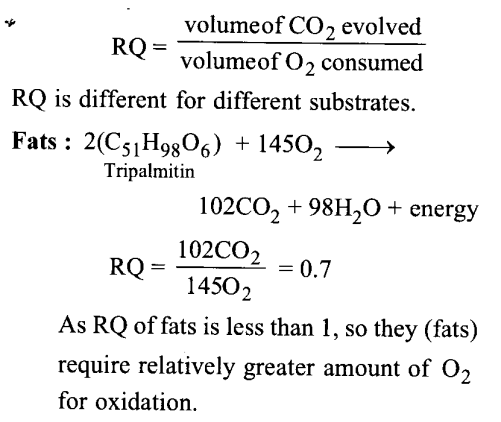
Question 11.
What is oxidative phosphorylation ?
Solution:
Although the aerobic process of respiration takes place only in the presence of oxygen, the role of oxygen is limited to the terminal stage of the process. Yet, the presence of oxygen is vital, since it drives the whole process by removing hydrogen from the system. Oxygen acts as the final hydrogen acceptor. Unlike photophosphorylation where it is the light energy that is utilized for the production of proton gradient required for phosphorylation, in respiration, it is the energy of oxidation-reduction utilized for the same process. It is for this reason that the process is called oxidative phosphorylation.
Question 12.
What is the significance of the step-wise release of energy in respiration?
Solution:
During oxidation within a cell, all the energy contained in respiratory substrates is not released free into the cell, or in a single step. It is released in a series of slow step-wise reactions controlled by enzymes, and it is trapped as chemical energy in the form of ATP.
Hence, it is important to understand that the energy released by oxidation in respiration is not used directly but is used to synthesise ATP, which is broken down whenever (and wherever) energy needs to be utilised. Hence, ATP acts as the energy currency of the cell.
This energy trapped in ATP is utilised in various energy-requiring processes of the organisms, and the carbon skeleton produced during respiration is used as precursors for the biosynthesis of other molecules in the cell.
VERY SHORT ANSWER QUESTIONS
Question 1.
What is anaerobic respiration? (Oct. 83)
Solution:
Incomplete or partial breakdown of fuel molecules into compounds such as ethyl alcohol, lactic acid in the absence of molecular oxygen.
Question 2.
Name the final acceptor of an electron in ETC.
Solution:
Oxygen is the electron acceptor of ETC.
Question 3.
The function of oxygen in aerobic respiration:
(i) It acts as the final electron acceptor.
(ii) It drives the whole process by removing hydrogen from the system.
Solution:
The function of oxygen in aerobic respiration:
(i) It acts as the final electron acceptor.
(ii) It drives the whole process by removing hydrogen from the system.
Question 4.
What is respiration? (Oct. 86)
Solution:
The oxidative process in which chemically bound energy from complex organic fuel molecules such as carbohydrates, proteins, and fats is captured in the form of ATP.
Question 5.
Where does the electron transport system operate in the mitochondria?
Solution:
Phosphofructokinase catalyses the formation of fructose 1, 6 bisphosphates from fructose 6-phosphate.
Question 6.
Give the function of phosphofructokinase in glycolysis.
Solution:
Hexokinase-helps in the phosphorylation of glucose.
Question 7.
Name the enzyme that catalyses the phosphorylation of glucose.
Solution:
The formation of acetyl CoA takes place in the mitochondrial matrix.
Question 8.
Where does the formation of acetyl CoA take place in a cell?
Solution:
The first step in the Krebs cycle is the condensation of an acetyl group (acetyl CoA) with oxaloacetic acid (OAA) to form citric acid and release the Coenzyme A.
Question 9.
What is the first step of reaction in the TCA cycle?
Solution:
Fatty acids may be converted to acetyl CoA before they from the respiratory substrates.
Question 10.
What is alcoholic fermentation?
Solution:
Alcoholic fermentation is the process by which yeast cells breakdown glucose into ethyl alcohol and carbon-dioxide under anaerobic conditions.
Question 11.
Name the oxidative pathway through which intermediate metabolites of glucose, fatty acids, and amino acids are finally oxidised.
Solution:
36 ATP/38 ATP molecules are obtained in the process of respiration and it is related to the aerobic respiration type.
Question 12.
What is lactic acid fermentation? (Oct. 2001)
Solution:
It is the process of fermentation by which lactose found in milk is converted to lactic acid by the action of lactobacillus.
Question 13.
What are the two molecules obtained by the action of aldolase from fructose -1, -6- biphosphate?
Solution:
ATP is produced.
SHORT ANSWER QUESTIONS
Question 1.
How is the proton gradient established?
Solution:
The proton gradient is established by passing proton (H+) from the matrix across the inner mitochondrial membrane into intermembrane space with the energy released during electron transfers in ETC.
Question 2.
Describe the steps in the formation of lactic acid from pyruvic acid.
Solution:
Pyruvic acid is catalysed by the enzyme lactic dehydrogenase. NADH formed in glycolysis is used up for the reduction.

Question 3.
How is ATP formed by the energy released during the electron transport system in mitochondria?
Solution:
ATP formations require an enzyme called ATP synthase. It has two components F0– F1. ATP- synthase becomes active in ATP formation when the concentration of H+ on the Fo side is higher than the F1 side. Fligher proton concentration in the outer chamber causes the proton to pass the inner chamber. F1 particle induced by the flow of proton through Fo channel. The energy of the proton gradient attaches the phosphate radicle to ADP. This produces ATP.
Question 4.
Give a detailed account of the net gain of ATP at a different stages of respiration.
Solution:
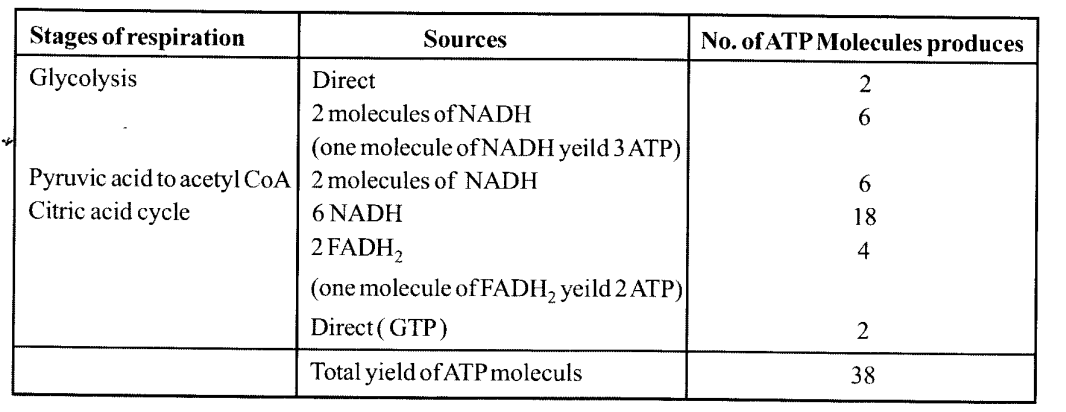
In most eukaryotic cells 2 molecules of ATP are required for transporting NADH produced in glycolysis to mitochondria for further oxidation. Hence net gain of ATP is 36 molecules.
Question 5.
Enumerate the functions of ATP.
Solution:
Functions of ATP:-
(i) ATP functions as a universal energy carrier of living systems.
(ii) ATP stores small packets of energy in its molecules.
(iii) It is mobile in the cell. Therefore, it reaches all parts of the cell away from the region of ATP synthesis.
(iv) It activates a number of chemicals by functioning as a phosphorylating agent.
(v) ATP provides energy for muscle contraction.
(vi) It is involved in the transport of substances against a concentration gradient.
Question 6.
Where is cytochrome c located? What is its function?
Solution:
Cytochrome c is located on the outer surface of the inner mitochondrial membrane. It acts as a mobile carrier for the transfer of electrons between complex III and complex IV of the electron transport system.
Question 7.
Define respiratory quotient.
Solution:
The respiratory quotient is defined as the ratio of the volume of carbon dioxide evolved to the volume of oxygen consumed in respiration.
Question 8.
What is oxidative phosphorylation?
Solution:
The whole process by which oxygen effectively allows the production of ATP by phosphorylation of ADP is called oxidative phosphorylation.
Question 9.
The energy yield in terms of ATP is higher in aerobic respiration than during anaerobic respiration. Why is there anaerobic respiration even in organisms that live in aerobic conditions like human beings and angiosperms?
Solution:
Aerobic organisms do face situations where oxygen availability is little. For example, overworked muscles do not receive enough oxygen during strenuous exercise. Similarly, deep-seated tissues of angiosperms do not receive enough oxygen through diffusion from outside. In such situations, only anaerobic respiration can help in the survival of the tissue.
Question 10.
Comment on the statement- “Respiration is an energy-producing process but ATP is used in some steps of the process”.
Solution:
ATP is required in all those reactions where phosphorylative activation of the substrate is required. Therefore, despite producing energy (as ATP), respiration requires ATP in certain steps, e.g., glucose – glucose 6-phosphate, fructose 6-phosphate —fructose 1, 6- bisphosphate.
LONG ANSWER QUESTIONS
Question 1.
Explain the major steps in Krebs’ cycle. Why is this cycle also called the citric acid cycle?
Solution:
Krebs cycle: This process occurs in the mitochondrial matrix.
Major steps of Krebs cycle are as follows :
- Acetyl Co-A, formed by the oxidative decarboxylation of pyruvic acid enters the Krebs’ cycle.
- It combines with oxalo acetic acid (OAA), a 4C-compound, to form a 6C-compound, citric acid; the reaction is catalysed by citrate synthase.
- Citrate is then isomerised into isocitrate.
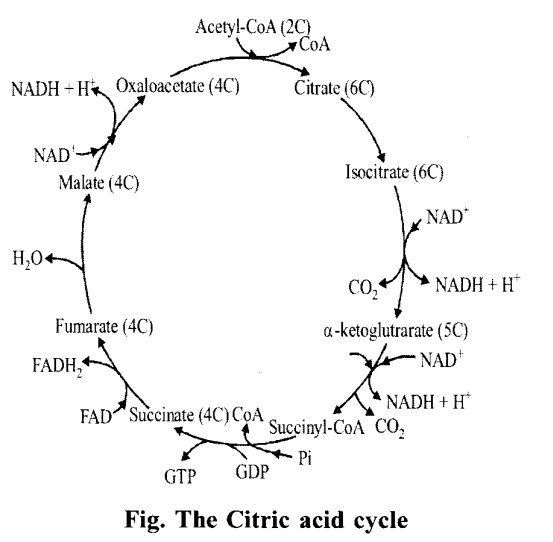
- Isocitrate is converted into oxalosuccinic acid in the presence of NAD and isocitrate dehydrogenase.
- Oxalosuccinic acid is then decarboxylated into a-ketoglutaric acid (KG), in the presence of a decarboxylase enzyme.
- a-ketoglutaric acid is converted into succinyl Co-A in the presence of NAD, Co- A, and enzyme a-ketoglutarate dehydrogenase.
- When succinyl Co-A is converted into succinic acid, one molecule of GTP is formed and Co-A is released.
- In the remaining part of the cycle, succinic acid is converted into OAA, so that the citric acid cycle can continue to operate.
- During this cycle, three molecules of NAD and one molecule of FAD are reduced to NADH and FADH respectively.
- This cycle is called as a citric acid cycle because the first product is citric acid which is 3-C compound.
Question 2.
Name the end product of glycolysis. Where is it produced in the cell? Discuss oxidative decarboxylation.
Solution:
Glycolysis results in the formation of two molecules of pyruvic acid, NADH, and ATP. It occurs in the cytosol of the cell.
Aerobic oxidation: One of the three carbons of pyruvic acid is oxidised to carbon dioxide in the reaction called oxidative decarboxylation. Pyruvic acid is first decarboxylated and then oxidised by the enzyme pyruvic dehydrogenase. The two-carbon units are readily accepted by coenzyme-A (Co-A) to form acetyl Co-A. The summary of the reaction is given in the following equation :

Thus, pyruvic acid enters the Krebs cycle as acetyl Co-A. Krebs’ cycle occurs in the mitochondrial matrix.
Acetyl Co-A, formed by the oxidative decarboxylation of pyruvic acid enters the Krebs’ cycle.
Question 3.
Represent schematically the interrelationship among metabolic pathways in a plant, showing respiration mediated breakdown of different organic compounds.
Solution:
Schematic representation among metabolic pathways showing respiration mediated breakdown of different organic molecules to CO2 and H2O:
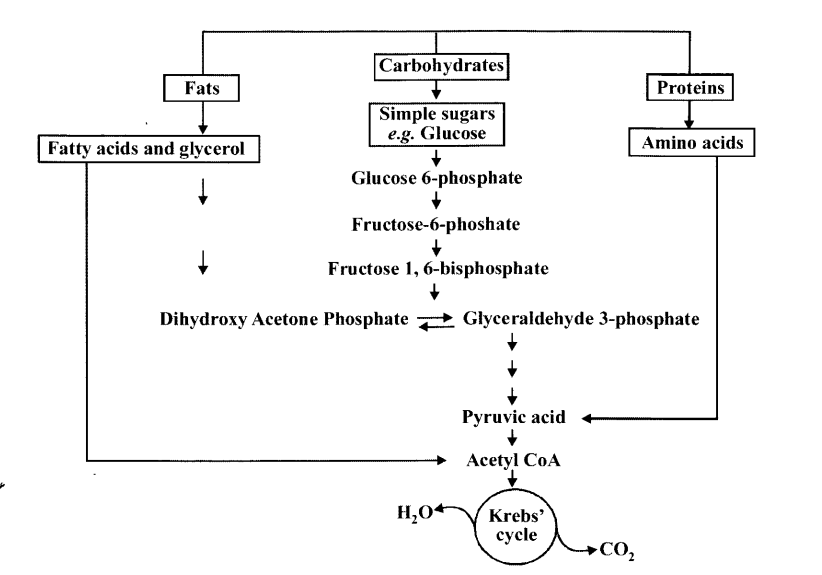
Question 4.
How do plants manage the exchange of gases? Give an overview of respiration in plants.
Solution:
Plants, unlike animals, have no specialized organs for gaseous exchange but they have stomata and lenticels for this purpose. There are several reasons why plants can get along without respiratory organs.
- Each plant part takes care of its own gas- exchange needs. There is very little transport of gases from one plant part to another.
- Plants do not present great demands for gas exchange. Roots stem and leave respire at a lower rate than animals do.
- Only during photosynthesis, large volumes of leases exchanged and, each leaf is well adapted to take care of its own needs during these periods.
- When cells perform photosynthesis, the availability of O2 is not a problem in these cells since 02 is released
- The distance that gases must diffuse even in large, bulky plants is not great. Each living cell in a plant is located quite close to the surface of the plant.
- Even in woody stems, the ‘living’ cells are organised in thin layers inside and beneath the bark. They also have openings called lenticels. The cells in the interior are dead and provide only mechanical support.
- Thus, most cells of a plant have attested to a part of their surface in contact with air. This is also facilitated by the loose packing of parenchyma cells in leaves, stems, and roots, which provide an interconnected network of air spaces.
- The complete combustion of glucose, which produces C02 and H20 as end products, yields energy. Most of the energy is given out as heat.
C6H12O6 + 6O2 → 6C02 + 6H20 + Energy - If this energy is to be useful to the cell, it should be able to utilise it to synthesis other molecules that the cell requires.
- The strategy that the plant cell uses is to catabolize the glucose molecule in such a way that not all the liberated energy goes out as heat.
- The key is to oxidise glucose not in one step but in several small steps enabling some steps to be just large enough so that the energy released can be coupled to ATP synthesis.
We hope the NCERT Solutions for Class 11 Biology at Work Chapter 14 Respiration in Plants, helps you. If you have any query regarding NCERT Solutions for Class 11 Biology at Work Chapter 14 Respiration in Plants, drop a comment below and we will get back to you at the earliest.